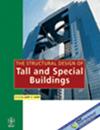Numerical collapse simulation based critical state analysis for framed‐wall structure subjected to earthquakes
IF 1.3
3区 工程技术
Q3 CONSTRUCTION & BUILDING TECHNOLOGY
引用次数: 4
Abstract
With the rapid developments of the constitutive theory, numerical methods, and computer software and hardware, full attention has been paid to establishing nonlinear structural models and investigating the nonlinear behavior, damage performance, and failure criterion of the structures. Consequently, this study introduces a precise analysis with a highly accurate level of simulation for an existing framed‐wall structure excited with strong ground motions. The incremental dynamic analysis (IDA) technique has been adopted to investigate the nonlinear behavior of the structure. The damage evolution and collapse pattern have been well captured in the structure based on the adopted damage model. The results showed that the maximum interstory drift (ISD) position varies at different seismic loads due to the damage initiation and propagation variation. The IDA curves show the end of the elastic stage at 0.70, 0.50, 0.70, and 0.20 g at San Francisco, Italy, Northridge, and San Fernando ground motions, respectively. Also, different collapse patterns of the structure have been observed at different ground motions and also at different intensities for the same ground motion. Therefore, the high‐rise building design should account for multiple collapse patterns. Moreover, a new IDA‐based technique is proposed to estimate the structure's maximum seismic capacity (MSC) and ensure it through the collapse analysis. The structure adopted in this study reaches its MSC at the San Francisco event at an intensity of 2.50 g. However, the MSC decreased by 40% at Italy and Northridge events and 60% at the San Fernando event. Since the seismic capacity of the structure is considered an essential ingredient in the design process, therefore, the findings of this study are supposed to lay the basis for the performance‐based seismic design of the structure.基于地震作用下框架-墙结构临界状态分析的倒塌数值模拟
随着本构理论、数值方法和计算机软硬件的迅速发展,非线性结构模型的建立以及结构的非线性行为、损伤性能和破坏准则的研究得到了充分的重视。因此,本研究引入了一种精确的分析方法,对现有的受强地震动激励的框架-墙结构进行了高度精确的模拟。采用增量动力分析(IDA)技术对结构的非线性行为进行了研究。基于所采用的损伤模型,较好地捕捉了结构的损伤演化和破坏模式。结果表明,在不同的地震荷载作用下,由于损伤发生和传播的变化,最大层间位移(ISD)位置发生了变化。IDA曲线分别显示了意大利旧金山、北岭和圣费尔南多地震动在0.70、0.50、0.70和0.20 g时的弹性阶段结束。此外,在不同的地面运动和相同的地面运动的不同强度下,已经观察到不同的结构倒塌模式。因此,高层建筑设计应考虑多种倒塌模式。此外,提出了一种新的基于IDA的方法来估计结构的最大抗震能力,并通过倒塌分析来保证结构的最大抗震能力。本研究中采用的结构在旧金山事件中达到其强度为2.50 g的MSC。然而,在意大利和北岭的比赛中,MSC下降了40%,在圣费尔南多的比赛中下降了60%。由于结构的抗震能力被认为是设计过程中必不可少的因素,因此,本研究的结果应该为基于性能的结构抗震设计奠定基础。
本文章由计算机程序翻译,如有差异,请以英文原文为准。
求助全文
约1分钟内获得全文
求助全文
来源期刊
CiteScore
5.30
自引率
4.20%
发文量
83
审稿时长
6-12 weeks
期刊介绍:
The Structural Design of Tall and Special Buildings provides structural engineers and contractors with a detailed written presentation of innovative structural engineering and construction practices for tall and special buildings. It also presents applied research on new materials or analysis methods that can directly benefit structural engineers involved in the design of tall and special buildings. The editor''s policy is to maintain a reasonable balance between papers from design engineers and from research workers so that the Journal will be useful to both groups. The problems in this field and their solutions are international in character and require a knowledge of several traditional disciplines and the Journal will reflect this.
The main subject of the Journal is the structural design and construction of tall and special buildings. The basic definition of a tall building, in the context of the Journal audience, is a structure that is equal to or greater than 50 meters (165 feet) in height, or 14 stories or greater. A special building is one with unique architectural or structural characteristics.
However, manuscripts dealing with chimneys, water towers, silos, cooling towers, and pools will generally not be considered for review. The journal will present papers on new innovative structural systems, materials and methods of analysis.

 求助内容:
求助内容: 应助结果提醒方式:
应助结果提醒方式:


